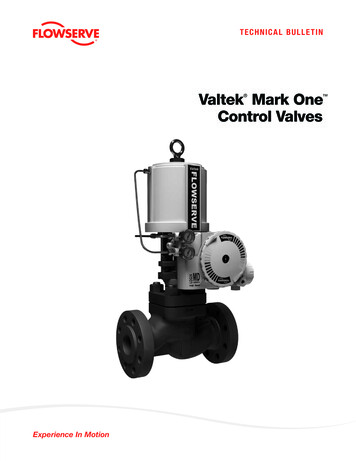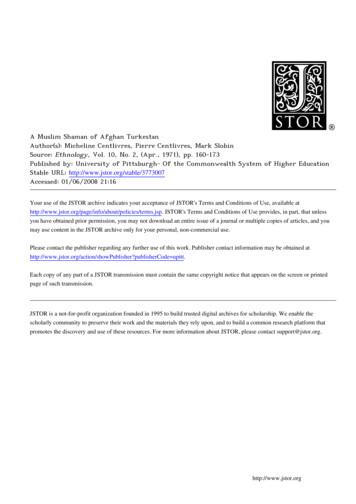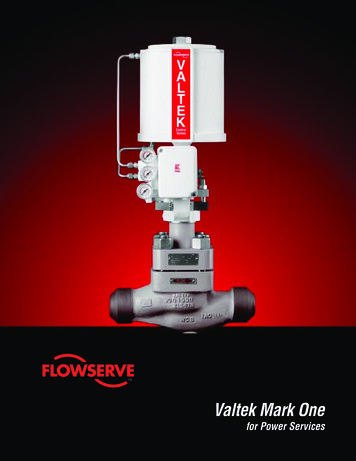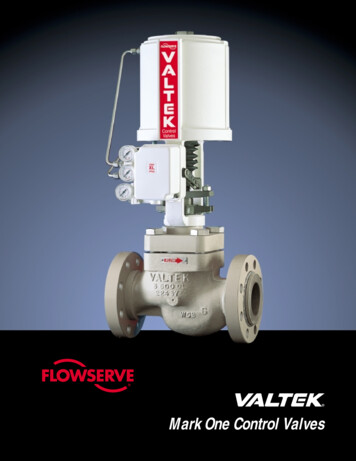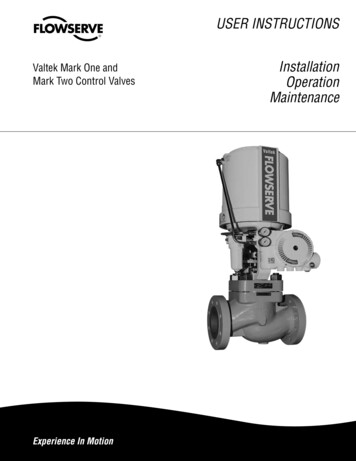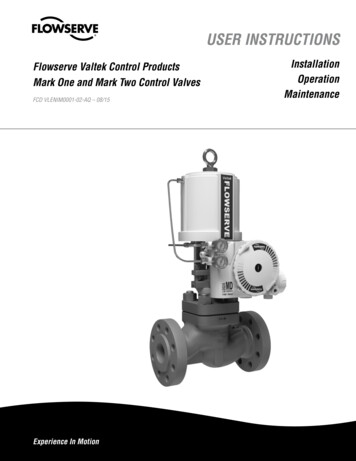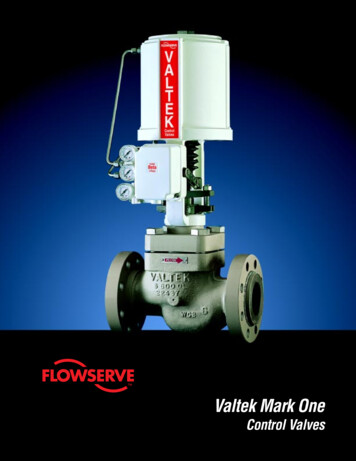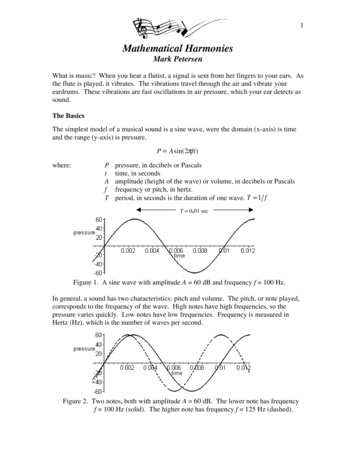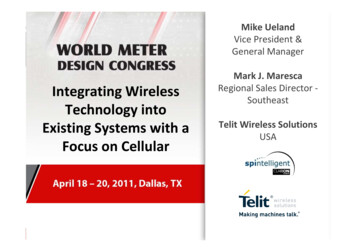
Transcription
Mike UelandVice President &General ManagerIntegrating WirelessTechnology intoExisting Systems with aFocus on CellularMark J. MarescaRegional Sales Director SoutheastTelit Wireless SolutionsUSA
Telit Corporate Overview Founded in 1986 Originally developed GSMhandsets for Europe Telit has more than3,000 active customers in 60countries 349 employees 14 offices in Denmark, UK, France,Germany, Korea, Italy, Spain,Israel, USA AIM Listed: LSE:TCM.L 2010 Sales- 132MEMEANorth AmericaRaleigh - USATrieste - ITALYRome - ITALYSeoul - KOREAAPACLatin AmericaSão Paulo BRAZILNORTH AMERICALATIN AMERICAEMEAAPACTelit Wireless Solutions Inc.Telit Wireless Solutions Inc.Telit Communications S.p.ATelit Wireless Solutions Co. Ltd Regional headquarters for NorthAmerica Regional headquarters for Latin America Global headquarters Sales and marketing for Latin America Product development, product TS certified manufacturing sitemanagement, of GSM/GPRS productsout of the main locations Trieste andCagliari, Italy Center of competency for automotiveproducts Sales and marketing for NorthAmerica Sales and marketing for EMEA Regional headquarters for the APACregion Product Development, productmanagement, production of CDMAand UMTS products Sales and marketing for the APACregion Primary manufacturing site
What is M2M?M2M is about enablingThe goal of M2M is to enable applications that allow businesses to improve productivity and competitiveness throughincreased efficiencies, cost-savings, and higher levels of butionENDEND CLIENTCLIENTENDEND USERSUSERSBenefits of M2M Opens up new revenue opportunities and streams Reduces cost of ownership through lower maintenance costs, resource costs, and intervention delays Improved security thorough optimized information control and reliability Remote control and real-time data for improved decision making Innovation and differentiation from value-added services Improved competitiveness and customer satisfaction
Global M2M Market PotentialThe M2M Cellular Mobile Vertical MarketGrowth EstimatesSecurity/Public SafetyMedical100Units 01120122013Source: Beecham Research 2009Source: ABI Research
M2M Driversm2mm2m FocusedFocusedOperatorsOperators2G2G rFurther ICICSUB-HEADLINEIntegrationIntegrationm2m 2.0LowerLower AirtimeAirtime&& jorMajor OperatorsOperatorsEngagedEngagedEmergingEmerging 3G3G
M2M Application Categories
Utilities Applications Utility Meters – Water andPower (AMR) Substation – Smart GridMonitoring and Control Oil & Gas Infrastructure –Drilling & Transport Telephone – Land LineReplacement
M2M areM2M DeviceMicrocontrollerSensorsM2M Module
M2M Network Services
Technologies-NA intHEADLINESUB-HEADLINEAT&T & Verizon For a full list of GSM carriers see www.gsmworld.comFor a full list of CDMA carriers see www.cdg.orgSprint Nextel & Clear
Global Frequency AllocationsNorth AmericaFour main bands“Quad band”Five main bandswith the possibilityof more .4G banding planscontinue to evolveEurope
Technology OverviewGSMGPRS/EDGECDMA/1xRTTUMTS/HSPAEVDOAir AccessTechnologyTDMACDMACDMACDMAChannel Size200 kHz1.25 MHz5 MHz1.25 MHz40 -80 kbps100-120 kbps200 kbps- 1 Mbps200 kbps- 1 Mbpsxxxxxx Real WorldBandwidthHEADLINESize ofSUB-HEADLINE xTechnologyCost ofTechnology TDMA vs CDMA Size (number of components required by the technology) Cost (processing power & number of components) GSM small size allow for BGA form factor
Technology Capabilities Each core access technologies has the ability to offer 3 mainservices: voice, SMS (text messaging) and IP data. Key technology differentiator is the data transfer speeds andcoverage area. 3G access technology like HSPA (GSM) or EVDO (CDMA) has amuch higher bandwidth then 2G access technologies like GPRS(GSM) or 1xRTT (CDMA).
Data Rates4G /1xRTTData Speeds(Real world)10-14 kbps20-100 kbps200-400 kbps500-1500 kbps5 MbpsData Speeds(Theoretical)14 kbps200 kbps384kbps7.2Mbps100 Mbps
GSM in North America GSM has 3 major carriers (operators) in North America AT&T (US) T-Mobile (US) Rogers (Canada)HEADLINE 2G GSM/GPRS has 4 main frequency bands (850/900/1800/1900)SUB-HEADLINE North America and most of South America uses 850 MHz and 1900 MHz Europe and most of rest of world uses 900 MHz and 1800 MHzHEADLINE 3G GSM (UMTS/HSPA) has 5 frequency bands(850/900/1700/1900/2100)SUB-HEADLINE North America 850, 1700, and 1900 MHz Europe and most of rest of world uses 900 & 2100 MHz
CDMA in North America CDMA has 4 major carriers (operators) in North America Verizon (US) Sprint (US)HEADLINE Bell Mobility (Canada)SUB-HEADLINE Telus (Canada)HEADLINE CDMA has 2 main frequency bands (800/1900)SUB-HEADLINE CDMA is mainly a North America and APAC technology.CDMA is not prevalent in Europe
CDMA vs. GSM Differences Incremental Development over GSM Shorter, Simpler Approvals Cycle Faster time to market Lower Cost Typical CDMA Approvals 4-8 weeks (vs. 8 weeks on GSM)CDMA Cost: Approx. 15K (1xRTT) vs. 20K (GSM)Easier Device Deployment Common Module footprints from many OEMsSimilar AT Command SetSimilar behavior on network30-60 days of development ApprovalOver-the-Air Service Provisioning vs. SIM ProgrammingSimple Device Log-on vs. APNNo SIM No Environmental or Vibration issuesSMTP vs. SMPP BindTechnology ‘Shelf Life’ Migration to LTE 7-10 YearsSource: KORE TelematicsCDMA drives time-tomarket down andmakes deploymentmuch more simple
CDMA Differences (Cont.) IP/Data Optimized Network Better in-building and rural coverage – Increased coverageOptimized data rounding (1KB/Month vs. 1KB/Session onGSM)Greater session persistency/‘Always on’ – Preferredoperation w/ 24 hr idle timer (vs. 4 hr. Idle timer on GSM)Mobile IP with Permanent Roaming – Consistent IPaddressing Fixed applications in roaming areasEnhanced cell tower hand-off – Fewer dropped sessionsHigh Speed, Low Latency – Improved data performance CDMA alone drives Solution optimizationbenefits and deploying CDMA in addition toGSM further drives: Increased Addressable Market Ability to embrace End User PreferencesGreater coverage optionsSource: KORE TelematicsBoth fixed and mobileapplications will benefit fromCDMA IP/Data optimization
Historically M2M 2G Coverage and service level consistency hasbeen more important than bandwidth 2G modules 1/3 the cost of 3G modules AT&T in particular is encouraging many oftheir customers to use 3G for new M2Mprojects
What Happened to EDGE? The recent rapid move towards 3G haspotentially dealt EDGE a fatal blow Performance/value ratio never served anyapplication well
3G Benefit to Carriers Better spectral efficiencySupport high bandwidth applicationsLonger voice talk timeMapping of all services onto HSPAFaster call set up time/lower latencySmooth migration to LTESource: Nokia Siemens
AT&T Mobile Data GrowthSource: AT&T
Effective RatesSource: ITU, Verizon, T-Mobile and Sprint
Carrier 3G/4G Strategies AT&T Continue with HSPA deployments; begin LTEdeployment 2H 2011. Verizon Available in 38 markets and over 60 major airports,and will cover nationwide 3G footprint with 4G LTEby the end of 2013. T-Mobile 200M POPs of HSPA 21; moving to HSPA 42 Sprint Using Clearwire’s WiMax network
What is the Impact on M2M Developers? Developers will need to make trade-offs in theshort term on connectivity choices 3G devices require more power 3G modules are bigger in size 3G modules are more expensive
What’s the status of the 2G network? T-Mobile: Has indicated it will be availablebeyond 2020 Verizon & Sprint: 1xRTT being used to supportvoice in 3G AT&T: Has not formally announced plans, butcertain applications will require 3G, especiallyconsumer products
M2M Total Cost of Ownership
3G/4G Forecast Second generation 3G modules will drivedown costs in 2011 4G modules for M2M will become feasible in2013 3G device costs won’t achieve parity with 2Gdevices for a number of years There will be carriers that support 2G for along time to come
LTE LTE is considered a 4G technology with speeds beyond 100Mbit/s Verizon & AT&T are leading the way towards LTE Initial LTE focus will be on data-only devices like notebook computers. Noinitial plans for voice support over LTE It will take Verizon & AT&T next 5 yearsto roll out LTE into all markets to getcomparable network coverage to 2G or3G AT&T stills needs 2-3 more years tocomplete roll out of their 3G HSPAnetwork29
Embedded SIM Existing SIM cards have proven reliabilityissues in harsh environments Solderable SIM package in earlyadoption phase Must be acquired directly from carrier Recommend placement next to modulefor flexibility
eSIM Update GSMA Embedded SIM Task Force is finalizingrequirements & use cases GSMA will work with ETSI to define a solution foreSIM in late 2011/2012 MULTI-IMSI: SIM configured for a set of 2-3 MNOs orfor a region, and activated only on the field
M2M VQFN8 SIM ChipVQFN-8-1 PackageExtended Temp Range: -40 to 105 JESD22-B103 VVF (Vibration Variable Frequency)JESD22-A101 THB (Temperature Humidity Bias)
MNO CertificationGE864-QUAD V2GC864-QUADV2 Telit endeavors to certify its product with major MNOs worldwide, especially on those having dedicated m2m areas. This effort is part ofTelit’s commitment to quality The sample of MNOs here represents Telit’s engagement where module(s) have been certified or where Telit has performed voluntaryfield testingNOTE: All logo marks depicted herein are property of their respective owners
Modules & Devices
Do I use a module? What is your expected annual volume? Is it over 3,000 units per year? What is your time to market? Do you have 12-18 months for a moduledesign? What is the size of your budget? Do you have 200K for R&D? Do you have 25K for certification?
Alternatives to modules? Finished product Any certified end product Terminal/Plug in modem Ex. Janus Remote Communications Pre-certified Reference Design Ex. Device Solutions
Benefits of Pre-Certified ModulesCustomer Benefits Time to market Design risk Extensively tested onchosen network Less certificationTelit target market Reduced componentobsolescence risk ManufacturingcomplexityGSM 864QTerminal
Keys to a Successful Application Select your partners earlyand work closely withthemModuleManufacturerHEADLINE Module manufacturerSUB-HEADLINE Carrier partner Test lab Understand the M2Mcomplex value chain Understand yourcertification requirementsIntegrator/CustomerCarrier /ServiceProviderCertificationLab
Design Challenges Design complexity – cellular is more complex than otherwireless technologies, like WiFi and Bluetooth, technically andcommercially. Hardwaredesign – must include an antenna system that meetsHEADLINEtheminimum performance requirementsSUB-HEADLINE Certification levels – industry, regulatory, and carrier Carrier contracts – monthly cellular charges Data requirements – what are the per month needs, what willthe business plan allow Management – how to use the cellular network, how to setup abackend sever to manage the data and make business decisions
The Right Technology Consider more than just the technical difference between 2G and 3G Cost of the technology – a 3G module might cost 2-3 times more then a3G module Bandwidth/ performance requirements – 3G will have higherHEADLINEbandwidth than 2GSUB-HEADLINE Cost to operation – cellular carriers may charge more for 3G monthlyrate plans compared to 2G rate plans (you will use more data) What does you business case allow? Are you a low cost, low data volume application like a vehicle trackingapplication? Are you a high bandwidth high cost application that requires streamingvideo?
Certifications for M2M Certification is often under-estimated by firsttime adaptors of cellular technology productSUB-HEADLINE Each technology has different certificationrequirements for the modules and end products. End application certification typically costs about 25,000
Worldwide Regulatory ApprovalsCanada: CRTS, ICEurope General Standards:CGF, R&TTE, CETurkey: TK, CEUnited States of America:FCC, PTCRBChina: SRRCMexico: NOM, COFETELKorea: KCC, MICGE864-QUAD V2Venezuela: CONATELTaiwan: DGTBrazil: ANATELGC864-QUAD V2RSA: ICASAAustralia New Zealand:A-Tick
Typical M2M Block ional)ON/OFFCircuitHEADLINEPower SupplySUB-HEADLINEor BatteryI/O’sADCDACMODULESIM CardHolder(only for GSM)Microcontroller(for core application& to send DATA)(optional)
Do I complete a design in-house? Have you designed with cellular before? Bluetooth, WiFi, ZigBee is not cellular . How much risk are you willing to take on? RF design – board layout Antenna Certification Is there an accelerated path to market? Telit Competence Center
Third Party Design Houses Experts in cellular modules designs Proven track record of getting throughcertification Reduce risk
M2M Product Design CycleDefine requirementsSelect M2M serviceprovider/carrierComplete PTCRB & FCCcertificationResearch suppliersComplete initial HS/ SWdesignComplete networkcertificationEvaluate suppliersDesign review and buildprototypesPre-production
CDMA vs. GSM Differences Incremental Development over GSM Common Module footprints from many OEMs Similar AT Command Set Similar behavior on network 30-60 days of development Approval Shorter, Simpler Approvals Cycle Faster time to market Lower Cost Typical CDMA Approvals 4-8 weeks (vs. 8 weeks on GSM)
